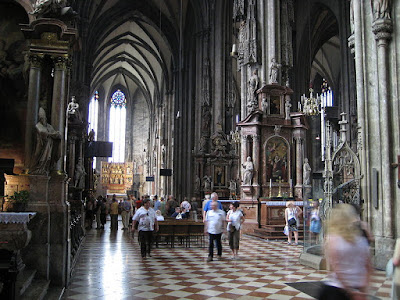St. Michael the Archangel by Guido Reni, 1636AD, in the Church of Santa Maria della Concezione in Rome, Italy.
Today is the great feast of St. Michael the Archangel! While in the revised calendar, it recalls all of the archangels, traditionally the feast focused only on St. Michael -- Quis ut Deus. As the birth of Christ is Christ's Mass, or "Christmas," so this was, to English speakers, Michael's Mass, or "Michaelmas."
St. Michael is mentioned in the book of Daniel in the Old Testament (10:13, 10:21, 12:1) several times in the New Testament, most notably in the book of Revelation:
"Chapter 12:7 Fierce war broke out in heaven, where Michael and his angels fought against the dragon. The dragon and his angels fought on their part, 8 but could not win the day, or stand their ground in heaven any longer; 9 the great dragon, serpent of the primal age, was flung down to earth; he whom we call the devil, or Satan, the whole world’s seducer, flung down to earth, and his angels with him. " [http://www.newadvent.org/bible/rev012.htm]
Also, in the Epistle of St. Jude:
"Chapter 1:9 (And yet, when the archangel Michael held debate with the devil, in their dispute over the body of Moses, he did not venture to accuse him insultingly; he was content to say, May the Lord rebuke thee.)" [http://www.newadvent.org/bible/jud001.htm]
St. Michael, then, is the champion of God against Satan, and an invaluable ally to the Faithful in their spiritual combat with the evil one. For early Christians, interestingly enough, he was associated with healing and care of the sick. Still, the health of the soul demands combat with Satan! The prayer of Pope Leo XIII is, on that account, an excellent one on this feast:
| English | Latin |
| Saint Michael the Archangel, defend us in battle; be our defense against the wickedness and snares of the devil. May God rebuke him, we humbly pray. And do thou, O prince of the heavenly host, by the power of God cast into hell Satan and all the evil spirits who prowl about the world seeking the ruin of souls. Amen. | Sancte Michael Archangele, defende nos in proelio, contra nequitiam et insidias diaboli esto praesidium. Imperet illi Deus, supplices deprecamur: tuque, Princeps militiae caelestis, Satanam aliosque spiritus malignos, qui ad perditionem animarum pervagantur in mundo, divina virtute, in infernum detrude. Amen. |
For more on St. Michael the Archangel, you might note:
Old Catholic Encyclopedia: St. Michael the Archangel
Catholic Saints Info: St. Michael the Archangel
For a bit more on this glorious feast, traditionally known as Michaelmas in English, you should read on here:
Fisheaters: Michaelmas
Just because it is named for St. Michael, here is the great Mont St. Michel in France:
[By b3rny - Image:65665753 5130dc1fa0 b Mont Saint-Michel.jpg, https://www.flickr.com/photos/49968830@N00/65665753/, CC BY-SA 3.0, https://commons.wikimedia.org/w/index.php?curid=5161828]
...and the Castel Sant'Angelo in Rome -- originally just the Mausoleum of Hadrian -- with the holy Angel referenced in the title, and pictured on the top of the structure, being St. Michael the Archangel:
[By 0x010C - Own work, CC BY-SA 3.0, https://commons.wikimedia.org/w/index.php?curid=24541042]
St. Michael, defend us in battle!
This blog will say a bit more about the other archangels (St. Raphael in October and St. Gabriel in March) on their traditional feast days...
Live well!























